The Magic of Misal Pav
Misal Pav, a delectable Maharashtrian dish, has taken the world by storm.
Maharashtrian Misal Pav Recipe is a scrumptious mixture made from sprouted beans (moth legumes) and potatoes with a rassa or stew made with uniquely varying misal masala and served with soft pav bread.
The dish is often accompanied by chopped onions, tomatoes, and a squeeze of lemon juice to enhance the flavors. While these components remain constant, regional variations and personal twists on the dish create an array of unique and delectable Misal Pav experiences.
Recently, a Mumbai-based eatery, Aaswad Upahar, received an accolade for its Misal Pav, which was awarded one of the best vegetarian dishes by a British food publication. The recognition has ignited a new wave of interest in this already popular dish. A lot of comments on the site requesting information on how to make misal pav have inspired us to share our house Misal recipe, influenced by our favorite Misal restaurant in Pune.
The passion surrounding Misal Pav is reminiscent of the fervor for ramen in Japan or pho in Vietnam. While everyone agrees that Misal Pav is delicious, the debate surrounding the best version of the dish is endless.
This classic dish’s open-ended definition enables chefs to shape it with their regional produce and gastronomic inclinations, as well as bring their own unique ideas. Although this often results in conflicting opinions on how to make misal pav, I believe this is the beauty of the dish.
Everyone has a differing opinion on where the “best misal in the world” can be found, and they will usually make it their mission to bring you along for tasting. They may even try to convince you that any misal you’ve eaten up until now doesn’t measure up!
Also, one thing to note is that calling Misal Pav Misal curry can be cringe-worthy for some Maharashtrians. While referring to Misal Pav as “Misal Curry” might not be the most elegant or accurate way to describe this beloved dish, we understand that it could help newcomers grasp the concept more easily.
Misal Pav is so much more than just curry or different from spicy gravy, with its unique blend of flavors, textures, and accompaniments that elevate it to a whole new level. However, if drawing parallels to the familiar world of curries assists in introducing this culinary gem to a wider audience, we’re all for it. After all, the more people who get to experience the delightful world of Misal Pav, the merrier!
Origins of Misal Pav Recipe
Misal Pav is believed to have originated in the western Indian state of Maharashtra during the early 20th century.
According to some sources, the dish was created as an affordable, nutritious, and filling meal for working-class people, who needed sustenance to fuel their long days. The combination of sprouted legumes, spicy rassa, and pav bread provided an ideal balance of proteins, carbohydrates, and flavors to keep the workers energized throughout the day.
Over time, Misal Pav spread throughout the region, becoming a popular street food and a staple in Maharashtrian households. Its versatility allowed for various regional adaptations, such as Mumbai, Kolhapur, and Nashik styles, each with its unique take on the classic dish.
Today, Misal Pav continues to be a beloved part of the culinary landscape in Maharashtra and beyond, representing the rich flavors and cultural history of the region.
Anatomy of a Misal Pav Recipe
Though I am not a food historian, allow me to attempt to explain what misal means to me. In Marathi language, the word translates as “mixture” – and for my part, I can separate its components broadly into following categories:
Misal Base (The Texture Component)
The mixture could consist of lentils, poha (flattened rice cereal), vegetables, and sev/farsan (which are textural components like croutons).
The lentils can vary from sprouted beans/legumes. Matki beans are the choice of sprouted beans/legumes which is more ubiquitous in Pune. However, the sprouted beans/lentils can be sprouted mung beans, peas, dried peas, and even garbanzos. Usually, the Sprouted beans (moth beans) are steamed or cooked separately but some people do cook them directly in the stew.
Many times usal – a spicy sprouts curry is also a dish commonly cooked in households. For example, a cooked sprouts curry made with moth beans is called matki usal. This cooked sprouts curry (moth beans usal) is many times repurposed next day to form the base of the spicy misal pav. One disadvantage of using usal (spicy sprouts curry) as base is that the resulting misal pav tastes more or less like the original sprout curry. Worse is sometimes the flavors dont blend well as the rassa cannot overcome the strong flavors of the sprouts curry, hence we prefer simply steamed lentils over a sprouts curry for the base.
However, as we said before there is no right answer and originally the dish misal (mixture) pav was probably born for the purpose of reusing many leftover ingredients like sprouts curry and other vegetables. In fact, our mom routinely uses leftover sprouts curry the next day to give it a facelift into a misal pav.
The vegetables are usually easily available boiled potatoes and raw chopped onions and tomatoes for the crunch. Chopped cilantro brings the aromatics.
The thin poha (flattened rice) is used either toasted and spiced with turmeric or the thick ones are prepared by soaking and stir steaming.
Sev and farsan, which are made from a flavorful chickpea flour batter that has been deep-fried into various shapes such as vermicelli, provide the perfect crunchy bite in broth. To further enhance this delightful texture even more, some roasted or fried peanuts with their skins on may also be included.
With limitless possibilities, the amount of potential outcomes is nearly unfathomable.
A note on Sourcing good Moth Beans or Matki
Securing top-notch moth beans, or matki, is essential for a stellar Misal Pav. These legumes form the dish’s foundation, supporting the tarri’s flavors. For the finest dried moth beans, visit local Indian groceries, online specialty shops, or organic produce stores.
When selecting dried moth beans, look for a uniform, medium-brown color without any signs of discoloration or damage. The beans should be firm, smooth, and free of wrinkles, cracks, or blemishes.
Misal Rassa (The stew)
However, the biggest variations in misal recipes that people are very passionate about are the rassa (stew) and the misal tarri recipe / the misal kat recipe (flavored oil).
Everyone makes their misal masala differently that can flavor the rassa or tarri hence due to the variations of misal masala there is a lot of variety. Many use a ready-made misal masala, while some grind their own misal masala. Some don’t use any special misal masala as such, but just make their rassa or tarri using the basic masalas and in a way put together their unique misal masala flavor profile while cooking the tarri or rassa itself.
Many people are unsure if garam masala / pav bhaji masala / goda masala is a suitable substitute for misal masala in cooking. The answer to this question is no; while garam masala / goda masala plays an essential role in everyday recipes, misal has its own unique flavors. Furthermore, overuse of garam masala / goda masala can lead to all dishes having the same taste – so be sure not to overuse them in your misal!
The combination varies from sweet to flavorful and spicy to searing sweat-inducing heat. There are quite a few fans of the jaggery-sweetened rassa at bedekar misal in Pune and they find vehement opposition from people who expect misal to have tear-inducing heat.
Due to this it’s a situation that there are people who call their rassa goda masala amati (due to their use of jaggery and goda masala like ingredients) in both complementary as well as critical ways!
The rassa ingredients vary just like a ramen broth can vary. They could include any of the following: chopped onions, coconut (dried or fresh), tomato, ginger, potatoes, red chili powder, turmeric powder, fresh chili pastes, cilantro, curry leaves, and ground sesame seeds.
Curry leaves and ground sesame seeds are not always common but some shops use the curry leaves seasonally and according to availability, but adding too much of curry leaves could mean that they overpower the flavor or the rassa tastes like south Indian stews which are brilliant in their own right, but will divert from a characteristic misal rassa.
Some chefs will use all of the above chopped finely and cook them to make their rassa without grinding cooked ingredients to smooth paste. While others would make a smooth paste (watan) of the varying coarseness of individual raw or cooked ingredients to make them into a stew.
The ground spice powder mixtures could include pounded cloves, cinnamon, coriander, mace, nutmeg, ground cumin seeds, sesame seeds, turmeric powder, etc. The whole spices typically are mustard seeds and cumin seeds.
Mustard seeds are not used ground but are used always in the tempering just like cumin seeds. Another key is whether mustard seeds or cumin seeds are used sparingly as the rassa should not taste of everyday cooking flavor profile where mustard seeds, as well as cumin seeds, are very prevalent.
Misal Tarri or Kat (The flavored Fat or oil)
The flavored oil is created while preparing the rassa where the stew boils and oil separates or is many times prepared and also served separately as seasoning oil to make the dish hotter and oilier for people who like to do so.
It tastes many times of burnt caramelized garlic, onions, and red chilly powder and is created as a dark red emulsion of oil and water which floats when added on top of rassa and strongly flavors the dish. For those who like a boldly flavored misal, this is where most of it comes from.
Misal Accompaniment (Pav or others)
The bread is almost always white bread served as rolls called pav (leading to the name misal pav) or as sliced bread.
Being from Pune we always serve our misal with the simple white slice bread. We have been consuming misal pav (bread) since we were kids, but it would be unfair to debate on its originality and origins.
However, this particular version of the dish has managed to remain a customary staple in Pune for so many years that it deserves recognition as an intrinsic tradition.
We often get mocked for our slice bread which as the critiques point out is not really “pav”. In India when you say “pav” nowadays lot of people equate it to the dinner rolls shaped bread or ladi pav or double roti kind of bread.
They have a valid point but I would like to put up some defense by providing some insight into the 80s. I think pav came to Mumbai and then Pune by the route of goa through the Portuguese bakeries. Before that, the Mughal or Irani bakeries in the 19th century were baking naans, etc, and probably were not so big on bread as this wonderful article by Vir Sanghvi delves into.
The British brought the archetypical sliced white wonder bread. As they occupied India and there was a demand created for this bread, it started being prepared in most Moghul/irani bakeries and was also the first to undergo some sort of industrialization in India.
In Pune even when we lived in the 80’s this sliced bread continued to be known as the “pav”. The word “pav” symbolized any and all kinds of bread for us growing up in the 80s.
Only much later did the dinner roll kind of “pav” became ubiquitously available in Pune with the advent of the popularity of pav bhaji. Specifically, the dinner roll type pav is called ladi pav and the slices from a bread loaf made in a bread tin or bread box are called “Peti Pav”.
Lemon wedges, finely chopped onion and cilantro
As an accompaniment whenever you make maharashtrian misal pav, it’s imperative to serve some lemon wedges on the side.
The freshly squeezed lemon juice a la minute really makes the dish sparkle. Also when people make maharashtrian misal pav they tend to make it pack lot of heat from the spices and lemon juice seasoning the dish dulls down the sharp heat.
Using freshly squeezed lemon juice from a real lemon wedge makes a world of difference and bottled vinegar or citric acid-laden lemon juice is not really a good alternative.
Finely chopped onion and cilantro are always added on top of the misal base to addsharpness of onion and aromatics of cilantro. As people eat misal pav, they may at times add more rassa and to balance it, add more chopped onions and cilantro, and always a good idea to have more on the side.
Misal Pav Across Cities
The versatility of Misal Pav has led to distinct regional interpretations, including Mumbai, Kolhapur (Kolhapuri Misal Pav) and Nashik styles and one from our hometown pune is the puneri misal. Mumbai’s Misal Pav is known for its moderate spice levels and the use of farsan (a mix of fried snacks) as a garnish. Kolhapur, famous for its fiery spices, boasts a Misal Pav that challenges even the most adventurous eaters. Nashik’s version is tamer in comparison, with a mild and slightly sweeter profile.
Despite the differences, Misal Pav enthusiasts everywhere enjoy heated discussions about their favorite variations and fiercely defend their preferred styles. This passion for Misal Pav is a testament to the dish’s ability to inspire culinary creativity and unite people through their love for this delicious Maharashtrian specialty.
Pune’s Love Affair with Misal Pav
The beauty of Misal Pav lies in its flexibility, which allows each chef to customize the dish based on local produce, preferences, and culture. This personal touch contributes to the dish’s broader definition and various styles, including our unique Pune-inspired Misal pav recipe.
Our Favorite Misal Restaurant in Pune
Nestled in the bustling Tulsi Baug area of Pune, Shrikrishna Bhuvan is a legendary Misal restaurant that has captured the hearts of food enthusiasts for decades. This iconic eatery is renowned for serving a delectable and authentic Pune-style Misal that leaves patrons craving for more. It’s called Shrikrishna Misal or Tulshibag Misal by some as well.
With its irresistible combination of flavors and spices, Shrikrishna Bhuvan’s Misal has become the gold standard for Misal lovers in the city. A visit to Pune is incomplete without indulging in the mouthwatering Misal experience offered by this humble yet extraordinary establishment.
Get ready, foodies! We’re about to embark on a culinary adventure to recreate the divine taste of Shrikrishna Bhuvan’s Misal Pav right in the comfort of your own kitchen. If you’re not in Pune, worry not – our detailed guidance will bring authentic flavors to your home, no matter where you are.
We know that the world of Misal Pav is vast and varied, with countless recipes and interpretations to discover. Our mission is not to claim that our recipe is the ultimate one but to share the version that we adore and cherish.
There are hundreds of Misal recipes out there, each with its unique charm and appeal. So, let’s dive in with an open mind, embrace the diversity, and relish the exquisite flavors of this beloved Maharashtrian dish. Laughter, fun, and a scrumptious meal await you on this exciting Misal Pav journey!
How to Make Misal Pav: Step-by-Step Instructions
We created a bit of a graphic to show the various possibilities at hand when creating your own Misal Recipe. We are calling it the misal map.
A misal recipe that typically packs a lot of heat can be characterized by the use of chili powder of the hotter variety in large quantities as well as a fried and dried spice mixture with onion and garlic as well as spices like cloves etc for more spice. The stew and Tari flavors are much smokier in this case. The crunchy mixture also is of the hotter kind in these cases many times.
The misal recipe that my mom used to make used to be crafted from a leftover curry she used to make from sprouted moth beans called matkichi usal. The sprouted moth beans curry (matkichi usal) will get dressed up with all the other flavorings and be presented as misal. She also used some sugar in her stew to help create a thin shiny layer of oil on top of the stew.
The BreakingNaan house misal recipe is more inspired by the Shri Krishna Misal recipe from Pune that we blogged about here. We craft a medium-hot misal that is full of flavor. Coconut, Ginger and garlic make this dish really come alive with brightness and freshness while the Kashmiri chili powder adds some subtle yet vibrant heat that balances it perfectly. This ensures there’s no overwhelming spice, but just enough to give your taste buds something special!
Our stew again keeps brighter flavors taking care not to burn or overly caramelize finely chopped onions, and ginger garlic paste. The same goes for the fresh frozen coconut we add to our misal recipe for the stew. The coconut brings some creamier sweetness to balance the acidity of ginger and tomatoes. We best describe this stew or rassa as bright with a little bit of heat and some earthy tones from the cumin and mustard.
The tari or the flavored oil is where we depart from a lot of the Puneri misal recipes. Typically more oil is added when making the stew itself in a lot of recipes that we scoured for. Then as the stew cooks this oil separates and floats to the top. The seasoning of the stew is thus adjusted as the flavors and heat are also carried in this oil. In this case, the rassa and tari are essentially cooked together.
The recipes we concoct are a result of us trying to recreate our favorite dishes without knowing the precise recipe. Though this approach is likely different than many other techniques, it appears to work well for us in terms of flavor and color intensity that it gives off.
We essentially make our tari separately. What this does is it allows us much more control over the flavor of tari. We also subscribe to the theory that flavored oil drizzled over ingredients brings out a lot more flavor perception than oil completely mixed into ingredients. This is probably by virtue of being present on the surface in every little bite we partake.
Cooking this misal tarri recipe separately in our misal recipe allows us to adjust the heat and oil in the dish based on the diner’s choice as well. More importantly, it lets us achieve this cleaner but hot and spicy flavor profile and also accounts for the bright red color of our favorite tari.
The way we cook this tari separately is also a bit unique and might not please the traditionalists. But we assume that tari is a flavored oil and a mechanism for carrying the essence of spices and heat and hence we borrow from the technique of making flavored oils. We start by mixing cold oil and ginger garlic paste and stir in a lot of the mild but colorful kashmiri red chili powder. We let this sit for 30 minutes and the flavors infuse really well and impart a beautiful red color to the oil.
We then bring some water and salt to a boil and reduce the heat and at the last moment mix in the oil without stirring too fast. We don’t want to emulsify the oil and water, but we slowly and gently want to cook the raw ginger garlic, and chili powder. We also do not want to overcook them or burn them with brutal boiling temperatures. So we gently warm this up as you will see a layer of glowing red form on the top with some foam. That is it, you have your flavorful tari ready for our misal recipe.
For the mixture, we opt for as few ingredients as possible which lend texture. We opt for a thin poha chiwda we make with some peanuts and turmeric. simply boiled potatoes and matki go on top. We definitely don’t overburden the dish with a lot of potatoes or a lot of matki. Also, we do not flavor the matki to make a usal. We tend to believe that usal muddles the flavors we have painstakingly created in the rassa and the tari and hence prefer to use just simply boiled matki. We top this off with fresh diced onion and cilantro. again for the texture instead of opting for farsan with myriad flavorings from additional spices like cumin, red chili etc we opt for a simply salted sev, large enough in size to not go soft immediately after coming in contact with the rassa.
To make the stew serving we ladle in the stew and top it in the end with the flavored tari oil, chili, and water. This seasons the rassa so that the bright, spicy heat of this oil is always easily perceived by our taste buds.
How to serve misal pav
For the mixture, we opt for a few ingredients as possible which lend texture. We opt for a thin poha chiwda we make with some peanuts and turmeric. Simply boiled potatos and matki go on top.
We definitely don’t overburden the dish when we serve misal pav with a lot of potatoes or a lot of matki. Also, we do not flavor the matki to make a usal. We tend to believe that usal muddles the flavors we have painstakingly created in the rassa and the tari and hence prefer to use just simply boiled matki.
We top this off with fresh diced onion and cilantro. Again for the texture instead of opting for farsan with myriad flavorings from additional spices like cumin, red chili powder etc we opt for a simple salted sev, large enough in size to not go soft immediately after coming in contact with the rassa.
To make the stew serving we ladle in the stew and top it in the end with the flavored tari oil, chili, water. This seasons the rassa so that the bright, spicy heat of this oil is always easily perceived by our taste buds.
As we discussed there are many ways of making a misal pav recipe, there will also be as many ways of eating misal as there are people at the table. Some will pour the whole bowl of rassa into the mixture and mix and start eating with bread. For me, this results in a mush towards the end of it. Others will drop spoonfuls of mixture into the rassa and eat it that way.
How to enjoy Misal Pav
I like to bunch my mixture to the side, and add my rassa a little at a time with a few squirts of lemon juice from the lemon wedges. I then mix in a bit of mixture with rassa and pair it with some bread thus keeping my sev crunchy, while I finish that portion.
View this post on Instagram
This time around we also tried capturing a clips of few seconds each as we cooked our misal recipe, so we have uploaded it to our youtube channel.
Let us know how the misal map looks for your misal recipe. How do you make your tari in your misal recipe? We would love to hear back from all of you.
Print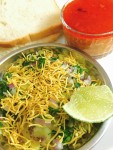
Puneri Misal
- Total Time: 1 hour
- Yield: Serves 4
- Diet: Vegetarian
Description
This is our recipe for Pune style Misal. It has medium heat and is flavored with a bright red chili ginger garlic infused oil. This is in the style of Pune Shri Krishna Misal Recipe.
Ingredients
- For the rassa (Stew)
- 2 tsp oil
- 1 tsp mustard seeds
- 1 tsp cumin seeds
- 2/3 cup chopped onion
- 1.5 TBSP Equal parts ginger and garlic paste made using some water
- 2/3 cup fresh coconut
- 1/2 cup chopped tomato
- 1 tsp kashmiri red chili powder (mild and colorful)
- For the Tari (Flavored oil)
- 2 tsp Equal parts ginger and garlic paste made using some water
- 3 TBSP vegetable oil
- 5 tsp kashmiri chili powder
- 1 tsp hot chili powder
- 2/3 cup water
- For the Misal
- 1 tsp oil
- 1/4 tsp turmeric
- 2 tsp peanuts
- 2/3 cup thin poha
- 1 boiled potato
- 0.5 cup boiled mataki lentil (moth)
- 0.5 cup chopped onion
- 1/4 cup chopped cilantro
- 1 cup Sev
- 4 Slices of white bread
Instructions
- For the rassa:
- start by heating the 2 tsp oil
- When hot add the mustard seeds, let crackle
- Add cumin seeds
- Add the onion and sweat making sure they do not burn or discolour. If required splash some water to cool down the pan
- After onions turn a bit soft add the ginger garlic paste and again stir making sure nothing changes color or burns. Add a splash of water and cook down
- Add fresh grated coconut and mix and cook without changing color or burning
- Add 1 tsp kashmiri red chili powder
- Add tomatos, mix and then cover to steam on low heat
- Open the lid and add 2 to 3 cups water according to consistency
- On medium heat, bring to boil covered
- Then simmer uncovered on low heat till a film of oil is formed on top
- Season with salt to taste
- For the Tari
- Add ginger garlic paste to a bowl
- Add the oil
- Add the two chili powders and mix thoroughly
- Let rest and infuse for 30 minutes
- Bring the water to a simmer on medium heat, add a tsp of salt
- Once simmering add the oil and spice mixture which was being infused and mix gently, do not stir vigorously to emulsify
- Set heat to low and let the mixture simmer so that a bright red layer of oil forms and the raw paste is cooked out. Set aside.
- For the mixture:
- Heat oil and add panuts to roast them on oil.
- Add turmeric and mix.
- Immediately add the thin poha and toss to coat with yellow oil and on medium heat stirring them gently toast them so they become crispier without burning them
- Mix the chopped onions with cilantro
- To Serve
- in a flat dish add 4 to 6 tsp of the thin poha toasted with peanuts and turmeric oil
- Add a 4 to 5 chopped cubes pf potatos and 2 to 3 tsp boiled mataki
- Add 2 tsp of chopped onions and cilantro
- Top with 0.25 cup sev
- In a bowl add 2/3 cup rassa
- Top this with 3 tsp of Tari – flavored oil and water mixture, skimming the top to get the oil in the last teaspoon
- Serve with a slice of bread, flat dish of misal, and the bowl of rassa plus tari
Notes
To know more about one of the absolutely delicious misals visit Shri Krishna Bhuvan in Tulsibaug Pune. We wrote about them here.
- Prep Time: 15 mins
- Cook Time: 45 mins
- Cuisine: Indian Maharashtrian
Keywords: Puneri Misal Shri Krishna Bhuvan Misal Tarri


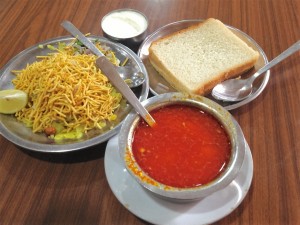
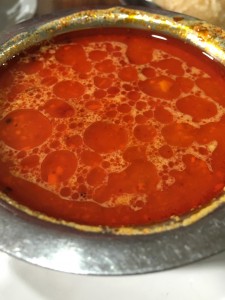
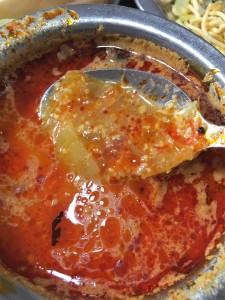
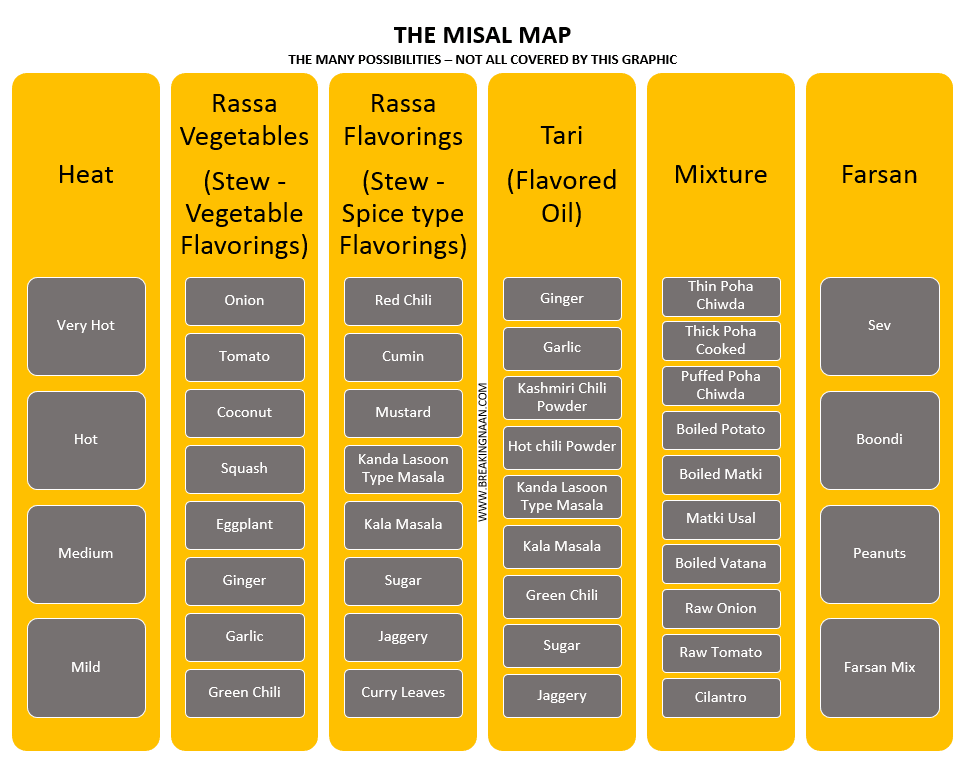
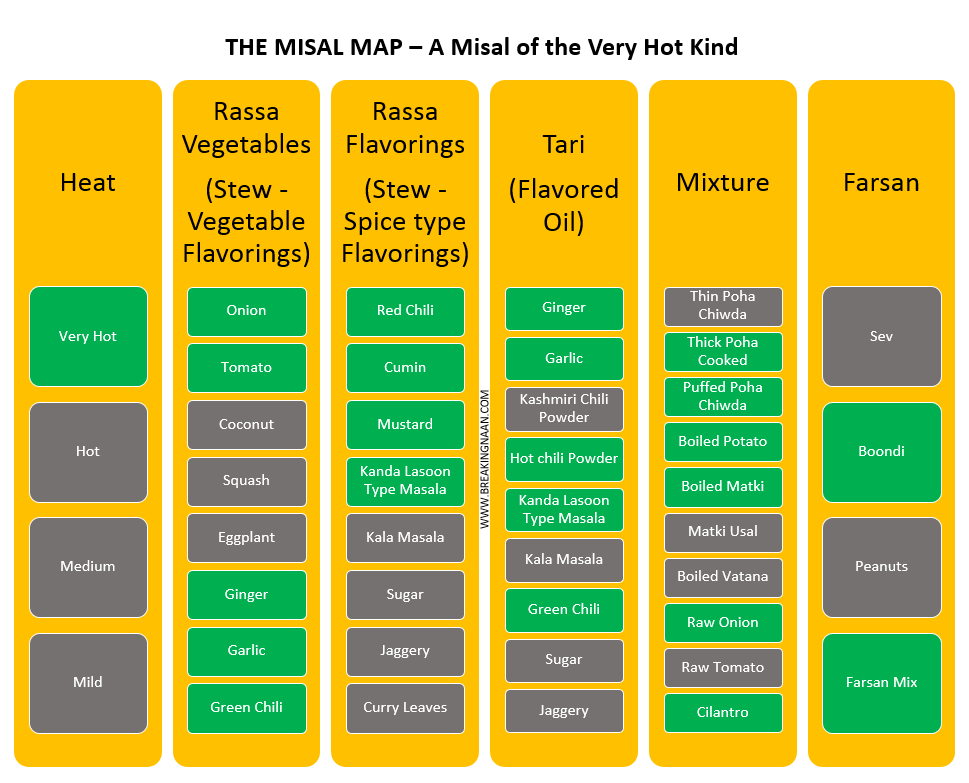
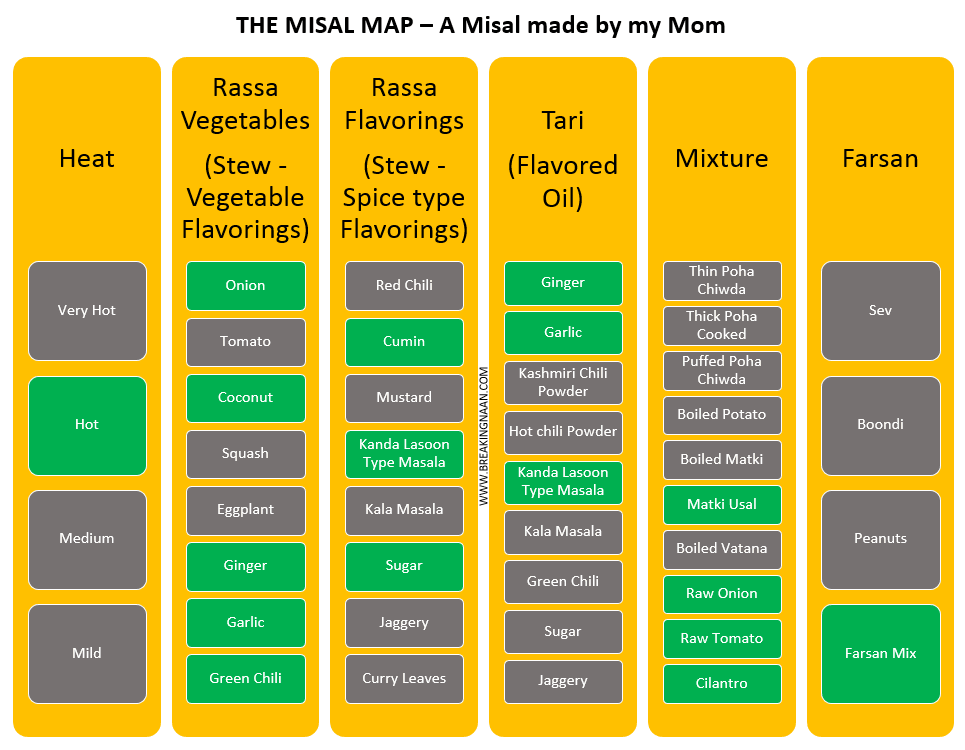
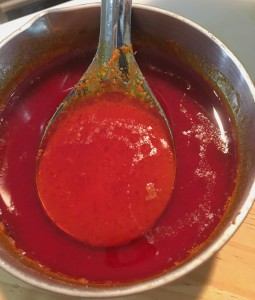
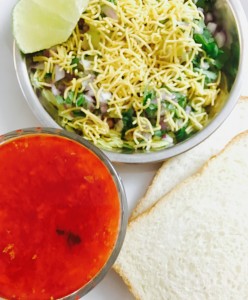
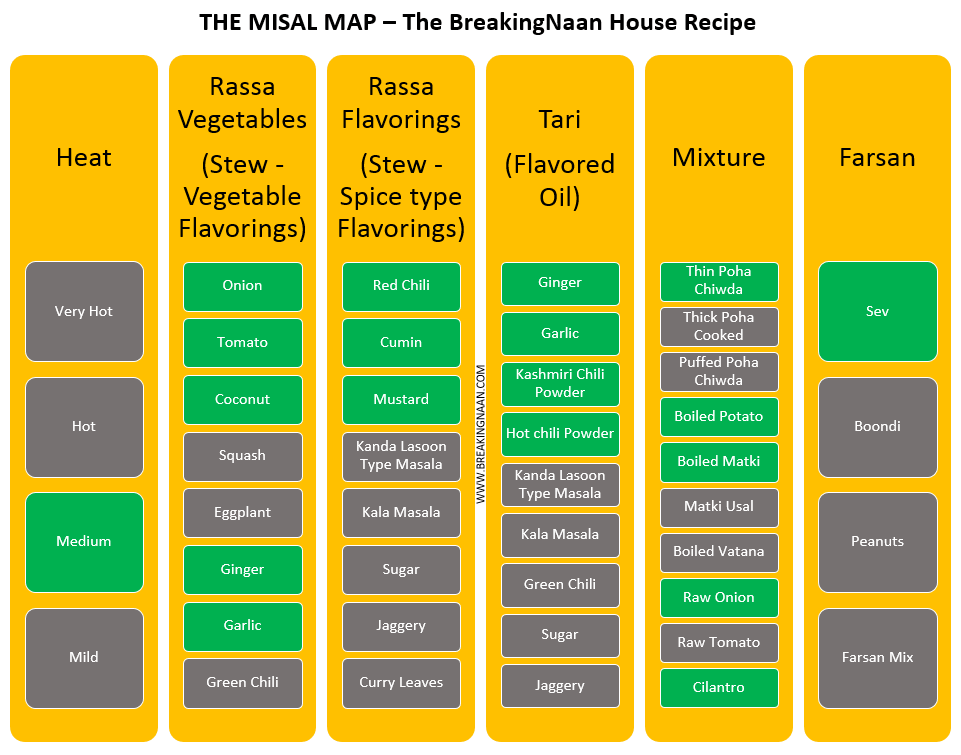
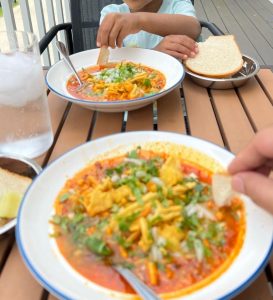
[…] used to make at tea-time. It is for the second time that we feature pohe on our blog after the misal recipe. For both the recipes we used the thin poha. Poha are dried flattened rice flakes and used […]
[…] This would have to be a dish from Western parts of India named Misal. This is a dish hugely popular in Indian cities like Mumbai, Pune, Kolhapur, Nagpur, and varies in composition every one mile that you travel! It was recently named the best vegetarian dish by a UK based publication. Much like Ramen Bowls or various recipes for Chili, Misal allows to create a different variation every day. Combine that with my love for it and Misal can easily last me a lifetime! We have written more about our love for Misal and a recipe here. […]
This is the best Misal pav I’ve had. Amazing recipe 🙂
Five stars!!!!
★★★★
The entire chat was oozing with infinite flavours, couldn’t be better. 5 stars to this recipe, and I would recommend this to everyone looking droolworthy for misal pav recipe…
★★★★
any one suggested best wrinkles